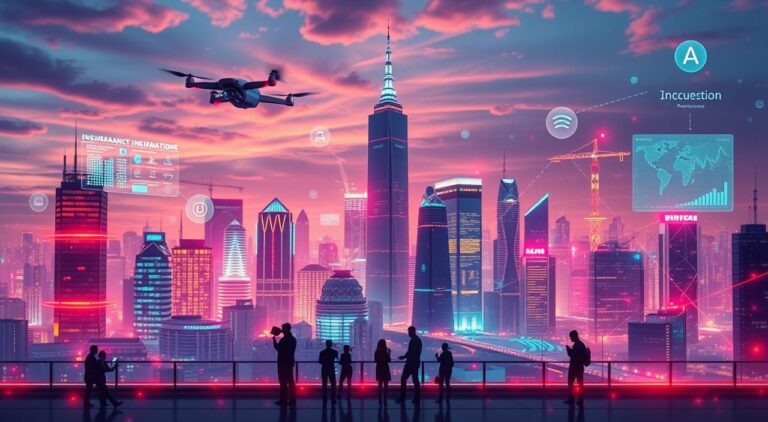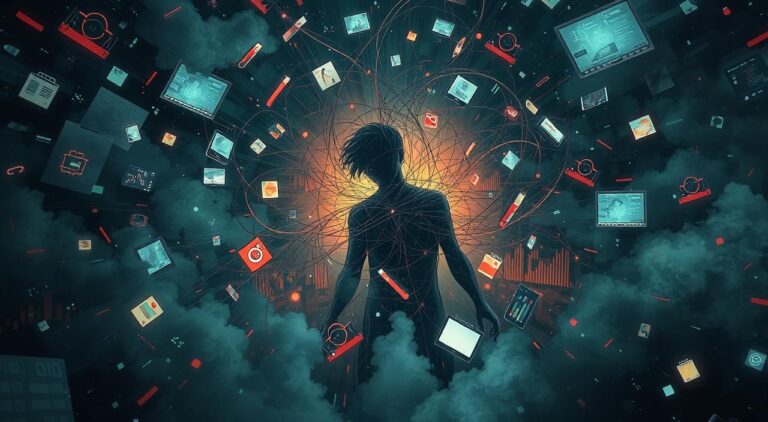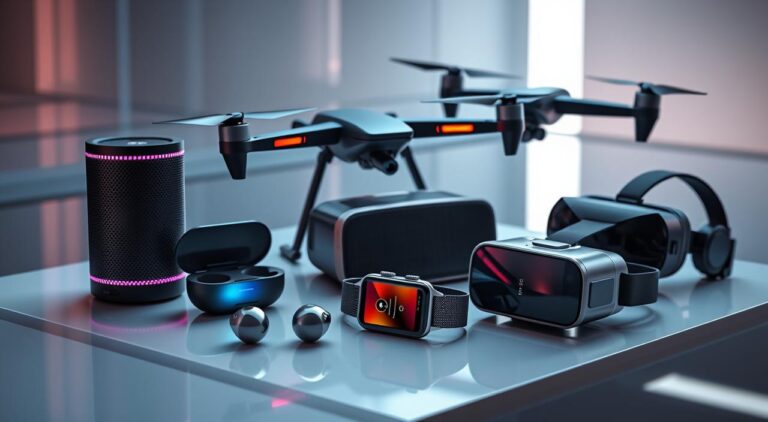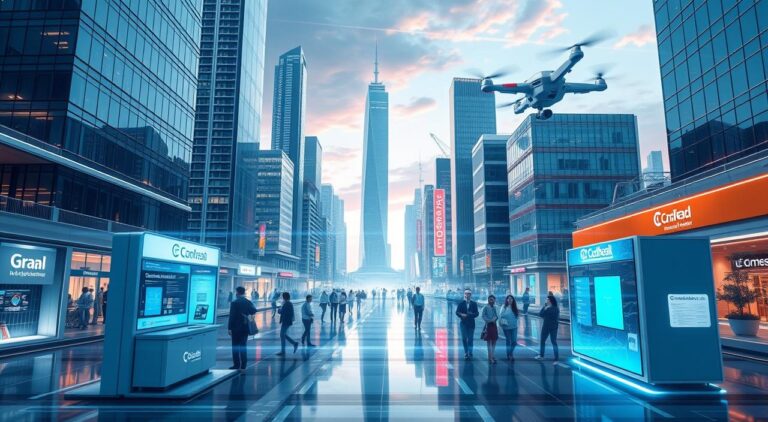
In today’s world, technology is everywhere. But are we really getting better with it, or are there hidden downsides? As we connect and automate more, it’s key to see the bad sides of tech and how they affect us. What if the tools we count on are actually hurting us?
In recent years, our lives have changed a lot. Now, over 60% of people use the internet1 and about 6.5 billion own a smartphone1. In 2021, over 2.14 billion people bought something online1. Video and audio streaming make up 70% of internet use1. The COVID-19 pandemic made us rely even more on tech, with 79.53% of Spanish adults using video calls to stay in touch1.
Key Takeaways
- Technology has both good and bad sides in our lives.
- It has changed how we talk and shop, but also made us more dependent, put our security at risk, and harmed the environment.
- Technology addiction affects 1.5% of people, with 21% of young folks at risk of mobile addiction1.
- Using tech the wrong way can make us less human and more isolated.
- Finding a balance between tech’s benefits and drawbacks is key for a better future.
Understanding Technology’s Impact in Modern Society
Technology is now a big part of our lives. We can’t live without things like TVs, phones, and computers. It has changed how we talk, work, and find information2.
A 2022 survey found that 73% of people use social media and messaging apps every day3. New tech trends help companies save time and money. They make communication and research easier.
The Digital Revolution Statistics
2 Over the last decade, job loss due to tech has gone up by 15%3. Tech has made traveling easier, boosting global sales and communication3. It has also made industries more productive, introducing new things like digital money.
Current Technology Usage Patterns
2 A 2021 study showed that 27% of teens worldwide face cyberbullying on social media4. More than 60% of Americans suffer from eye strain from screens4. Too much screen time can make people less active, with 38% of parents worried about their kids not exercising enough.
Global Technology Adoption Rates
3 Technology has led to fewer jobs in some areas, as machines do more work3. This means humans might do less in some jobs.
4 Technology’s impact on kids is big, affecting their growth and happiness4. Too much tech can cause mental health issues. Less social media use means fewer feelings of sadness and loneliness.
“Technology has become an integral part of our daily lives, transforming the way we communicate, work, and access information.”
4 1 in 5 Americans get their news from social media, more than print media4. Too much tech can harm kids’ social skills, creativity, and emotional health.
| Positive Impacts | Negative Impacts |
|---|---|
| Increased productivity and efficiency | Increased job loss due to automation |
| Improved global communication and connectivity | Decreased human capital and employment |
| Innovative financial solutions like digital currencies | Negative impact on child development and well-being |
| Streamlined research and information access | Physical and mental health concerns due to excessive screen time |
4 The American Academy of Pediatrics says kids under 18 months should avoid screens4. Kids 2-5 should watch no more than 1 hour of TV per day4. Before Covid-19, too little exercise was causing 5.3 million deaths worldwide234.
What is the most disadvantage of technology?
Technology has changed our lives for the better, making things more connected and convenient. Yet, it also has downsides that we need to think about5. Many people, almost 40%, are addicted to technology, and 47% of young adults are hooked on their smartphones6.
Technology can harm our mental health. Using social media too much can make us feel lonely, with 46% of adults feeling isolated after spending over five hours a day online6. It can also lead to anxiety and depression due to cyberbullying and other online issues6.
Too much tech use can hurt our bodies too. It can cause eye strain, hand pain, and keep us from sleeping well5. Students might even get hurt more because they sit too much5. Online, people might say things they wouldn’t in person, which can be risky6.
Technology also affects jobs and work. Automation might take away 75 million jobs by 2022, especially in manufacturing6. It raises questions about fairness and ethics, with 87% of people wanting companies to care about society as much as profits6.
We must recognize the bad sides of technology, like mental and physical health problems, job loss, and ethics issues. By using technology wisely, we can enjoy its benefits while avoiding its downsides5.

| Disadvantage | Impact | Statistic |
|---|---|---|
| Privacy Concerns | Data breaches affecting organizations | 66% of financial services and 55% of healthcare entities in the last two years6 |
| Health Implications | Physical health issues due to sedentary work environments | 70% of tech employees report physical health issues, with obesity rates increasing by 22% among tech professionals6 |
| Social Disconnect | Feeling socially isolated due to excessive social media use | 46% of adults who spend more than five hours a day on social media6 |
| Addiction | Struggling with technology addiction | 40% of the global population, with smartphone addiction being prevalent among 47% of young adults6 |
| Job Displacement | Jobs expected to be displaced by automation | 75 million jobs by 2022, with the manufacturing industry facing the highest impact6 |
| Ethical Dilemmas | Importance of balancing business and societal interests | 87% of consumers believe companies should place equal weight on society’s interests and business interests6 |
In conclusion, technology has many benefits, but we can’t ignore its downsides. By facing these challenges, we can use technology in a way that helps us without harming us5.
Technology Addiction and Mental Health Concerns
In today’s world, digital devices and social media are everywhere. They can cause serious mental health problems. Too much time on social media and phones can lead to eye strain, trouble focusing, and even depression7. A 2017 study found that young adults who used social media a lot felt lonely and isolated7.
Social Media Dependency
A 2016 review showed a link between social media and mental health issues like depression and anxiety7. People who saw negative interactions online felt more depressed and anxious7. Internet addiction, especially in teens, is linked to depression, low self-esteem, and feeling lonely8. Studies also found that using platforms like Facebook and Instagram can lead to anxiety and depression8.
Screen Time Impact on Well-being
Looking at screens for too long can cause eye problems like blurred vision and dry eyes7. The American Optometric Association suggests taking a 20-second break every 20 minutes of screen time7. Using phones can also lead to bad posture and musculoskeletal issues7. Using devices before bed can mess up your sleep because of blue light7. Being too sedentary from technology use can also harm your health7.
Digital Anxiety and Depression
Too much tech use in kids can lead to poor grades, lack of focus, and developmental delays7. Teenagers who use digital media a lot are more likely to have ADHD symptoms7. Parents should limit screen time for kids, following the American Academy of Pediatrics’ guidelines7.
The widespread use of digital devices and social media has caused serious mental health problems like social isolation, anxiety, and depression. As technology becomes more part of our lives, we need to tackle these digital mental health issues. We must find ways to have a healthy relationship with technology.
“95 percent of users of the Big White Wall online platform noted an improvement in their mental health symptoms.”8
| Metric | Industrialized Nations | Developing Countries |
|---|---|---|
| Per Capita Expenses on Mental Health Care | $33.39 | Less than Industrialized Nations |
| Effectiveness of Telemedicine in Mental Health Counseling | 53% Reported Improvement in Depression | 50% Reported Improvement in Face-to-Face Counseling |
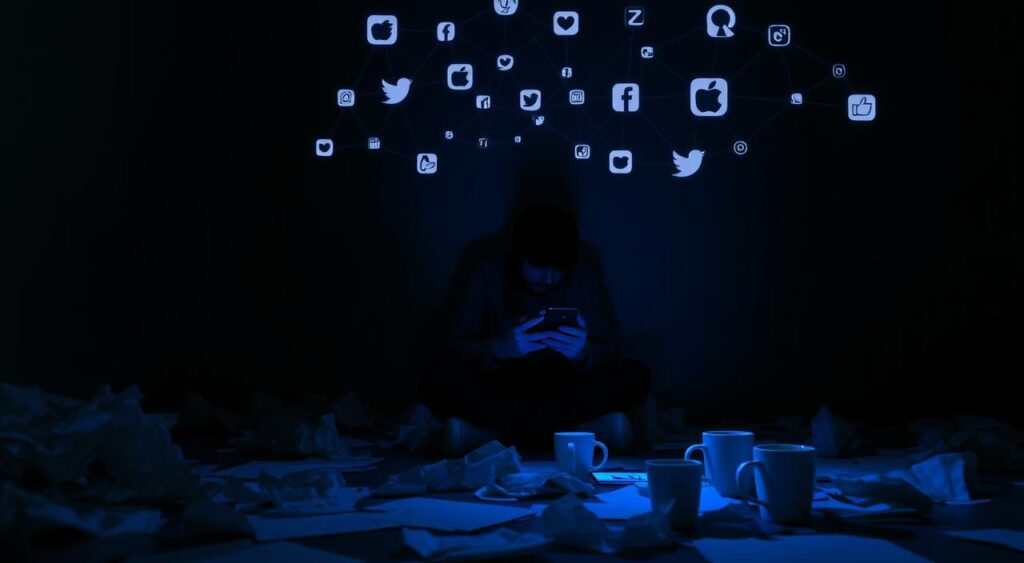
Privacy and Security Risks in the Digital Age
In our digital world, keeping our data safe is more important than ever. Every day, there are about 350,000 malware attacks worldwide9. This shows how big the problem of cyber threats is for both people and businesses.
Many U.S. states don’t have strong data protection laws. This means companies can use and share our data without telling us9. This is different from the European Union’s GDPR, which protects our privacy better9.
Creating strong digital privacy measures is hard and can cost a lot9. The Facebook-Cambridge Analytica scandal and the Schrems II ruling on the EU-US Privacy Shield show why we need to protect our data10.
To fight these problems, we need good cybersecurity plans. Every 39 seconds, a hacker attack happens, and data breaches cost $4.88 million on average in 202411. Good cybersecurity can protect our systems, save money, and keep customers trusting us11.
Finding the right balance between tech and privacy is key in our digital world. We must keep improving security, better manage data, and give users more control over their info. This will help make our digital world safer and more trustworthy.
“Cybersecurity has evolved into various specialized areas, including network security, application security, cloud security, information security, endpoint security, mobile security, identity and access management, Internet of Things security, data security, and operational security.”11
| Cybersecurity Benefits | Cybersecurity Challenges |
|---|---|
|
|
As our digital world keeps changing, finding the right balance between tech and privacy is crucial. We must keep improving security, better manage data, and give users more control over their info. This will help make our digital world safer and more trustworthy91011.
Environmental and Health Implications
Our use of technology is growing fast. We need to think about the risks to our health and the planet. From how tech affects our bodies to the harm it causes to the environment, we must consider the future.
Digital Device Health Effects
Using digital devices too much can hurt our eyes and cause dryness. To avoid this, try the 20-20-20 rule. It means taking a 20-second break every 20 minutes to look at something 20 feet away. A 5-year study found an association between texting and neck or upper back pain in young adults.12
Environmental Impact of Tech Production
The rise of technology has harmed our planet. It has sped up climate change and deforestation. Renewable energy now makes over 20% of the UK’s electricity and aims for 30% by 2020.12 In Australia, rooftop solar installations grew from 4,600 to over 1.6 million between 2007 and 2017.12 Between 1990 and 2015, the world lost 1.3 million km2 of forest, mainly for farming and logging.12
Physical Health Concerns
The way we make technology also affects our health. E-waste, full of toxic stuff like lead and mercury, is a big problem if not handled right.13 Bad e-waste management pollutes the air and water, harming health and the environment.13
We must think about these issues as we keep using new tech. By being green, using clean energy, and managing e-waste well, we can lessen the harm. This way, we can protect our planet and health.

Social Isolation and Communication Changes
Technology was meant to connect us, but it has led to more isolation and changed how we talk to each other. A study by the Polytechnic University of Madrid and the University of Oviedo found that too much phone use makes us feel isolated and causes problems14.
Now, we talk more online than face-to-face. This change has affected our social lives and how we feel14.
- By 2022, 66 percent of the world’s population used the internet14.
- When the UK went into lockdown, Zoom downloads skyrocketed to 2.13 million worldwide, up from 56,000 a day before14.
- Experts predict over 50% of couples will meet online by 203514.
- 47% of people think online dating helps shy people find love14.
- In July 2020, 58% of customer interactions were online14.
Technology has made talking easier, but it also brings problems like cyberbullying and “catfishing.” A YouGov poll showed 25% of adults have been bullied online14. In 2018, 9% said being catfished hurt their mental health14.
The pandemic made these issues worse, with a 106% rise in reports to the National Center for Missing & Exploited Children (NCMEC) CyberTipline during lockdown14. Finding a balance in our use of technology is key to keeping our social connections strong.
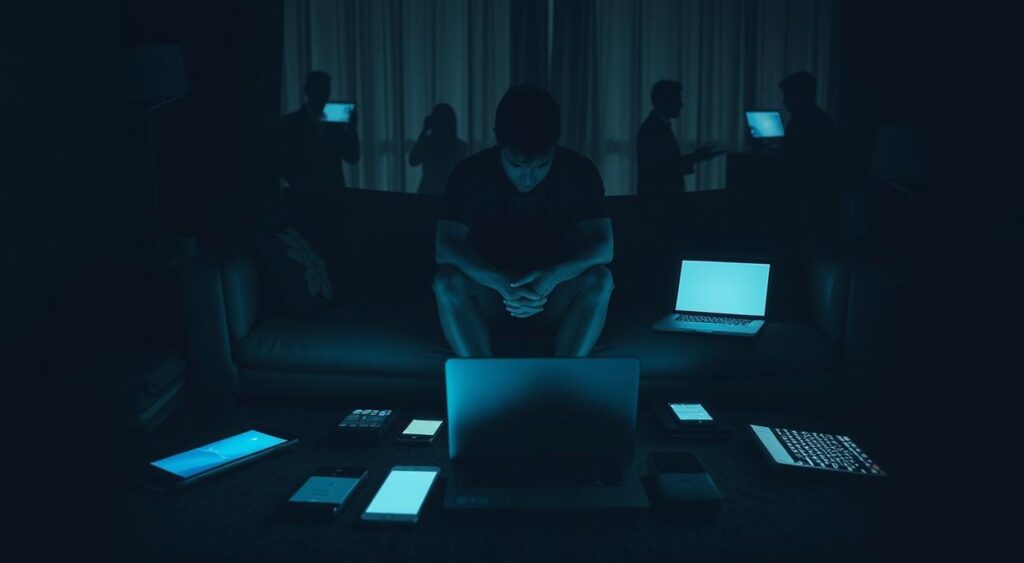
| Metric | Value |
|---|---|
| Email Users Worldwide | 3.9 billion (2019)15 |
| Emails Processed Daily | 293.6 billion (2019)15 |
| Emails Received per Day (Average) | 12115 |
| Employees Missing Company Information | Almost 75%15 |
| Employees Motivated by Regular Updates | 85%15 |
The move to digital communication has brought both good and bad changes. It helps us stay in touch but also leads to feeling alone and changes how we talk. Finding a balance is essential to enjoy technology’s benefits while keeping our social connections and communication skills healthy.
Educational Challenges in the Digital Era
Technology has changed education, bringing both good and bad. Digital tools have made learning more engaging16. Yet, there are worries about how tech affects grades and student happiness.
Learning Disruption Factors
Too much screen time can hurt grades and focus16. It can also slow down language and social skills16. Research shows teens who use digital media a lot might develop ADHD symptoms16. Also, the dominance of big tech companies in schools raises ethical questions16.
Digital Divide Issues
The digital divide makes education unfair, especially for those from poor families or rural areas16. They often lack the devices and internet needed to keep up16. The COVID-19 pandemic has made these disparities worse, highlighting the need for better tech access16.
Student Performance Impact
Technology can help learning, but it’s not a solution to all problems17. The internet can also spread wrong information, making things harder for students17. Students using phones in class can get distracted and do poorly17. Some students even prefer face-to-face classes, showing they don’t like online learning as much17.
As technology becomes more common in schools, finding a balance is key. We must make sure all students have the same chance to learn well, both online and in person.
Workplace Technology Concerns
Today, technology is both a blessing and a curse in the workplace. It can make us more efficient but also brings big challenges. Companies must handle these issues carefully18.
One big problem is distractions. Things like phone calls, emails, and webinars can interrupt our work a lot18. This has made us lose skills in talking to each other, which hurts our work and relationships18.
Also, keeping up with new technology costs a lot of money and time. This can hurt a company’s profits and make employees unhappy18. There’s also the risk of data theft by employees, which can cause big financial and privacy problems18.
Even so, technology has many good points. It can really help us work better and perform well as a team19. But, we need to deal with the problems it brings, like distractions, communication issues, and security risks. This way, we can make our work place better and more enjoyable20.
As technology keeps changing, companies must stay alert and act fast. By tackling these tech-related problems, businesses can make the most of workplace technology. This will help create a dynamic and tech-savvy professional setting19.
Conclusion
Technology has changed our world in many ways. It has made things more efficient and helped us communicate better21. But, it also has its downsides like addiction, security risks, and harm to the environment2122.
To make the most of technology, we need to find a balance. We should use it wisely and protect ourselves from its negative effects2122.
First, we should make sure everyone has access to technology22. We also need to keep our personal info safe online22. Teaching people to use technology in a healthy way is important too22.
In schools, teachers need training to use technology well23. This will help students learn better and avoid problems23.
By facing these challenges and using technology wisely, we can make our lives better2123. Let’s keep using technology in a way that helps us, not hurts us.

